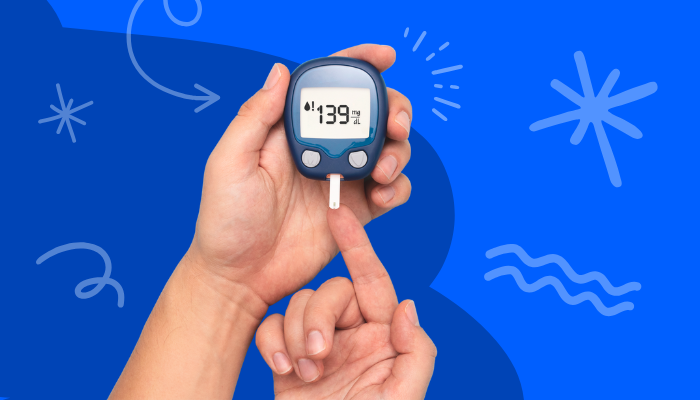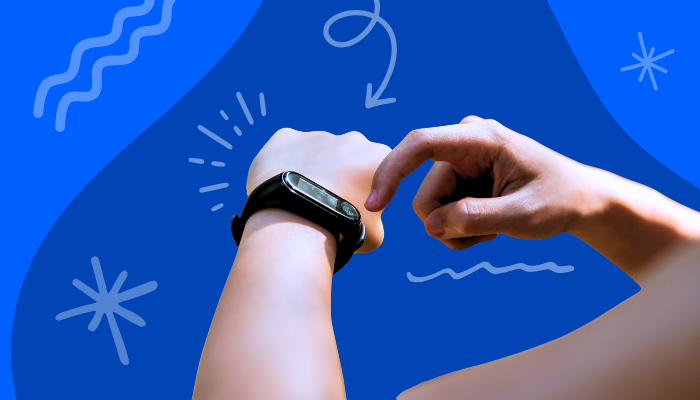Tired of multiple daily injections to manage your diabetes? An insulin pump might be a good alternative, though it’s not the best choice for everyone.
In this article, we’ll explain what you need to know about insulin pumps for diabetes type 1 and type 2, including how they work and what they cost. If you think an insulin pump may be a good option, talk to your doctor to find out if you’re a candidate and how it can fit into your routine.
Table of Contents
What is an Insulin Pump?
An insulin pump is a wearable, computerized medical device that delivers insulin throughout the day without injections. They’re available in two styles: tubed or tubeless.
Tubed pumps: Also known as tethered pumps, this style uses a thin tube outside of the skin to deliver insulin. The tube is a few inches long and connects the insertion site (often at the stomach) to the pump, which is about the size and weight of a deck of cards and clips to your belt. A popular example would be the Medtronic MiniMed 780G insulin pump.
Tubeless pumps: Also known as patch pumps, this style is a small pod-like device that uses a short plastic tube under the skin to deliver insulin. The pod is about the size and weight of a matchbox and attaches discreetly to the body (often the stomach, thigh, or arm). The Omnipod 5 insulin pump is a reputable option on the market.
OmniPod 5 Pods - Pack of 5

$ 329.70
$ 387.53
The Omnipod 5 Pods are for use with the automated, tubeless and waterproof insulin delivery system - Omnipod 5 System which is also compatable with the Dexcom G6 CGM. The Pod can be worn almost anywhere an injection would be… read more
Some people prefer tubeless pumps because they’re smaller, easier to manage, waterproof for showers and swims, and less likely to get caught during activity. Others may prefer tubed pumps because they can be easily disconnected (like during site changes or intimacy).
How Do Insulin Pumps Work?
All insulin pumps have the same basic purpose: delivering insulin from the built-in reservoir to the subcutaneous tissue, or the layer of fat under the skin. But they can do this in two ways: through basal doses or bolus doses.
Basal (background) insulin: This type of dosage releases small, steady, programmed amounts of insulin throughout the day to maintain stable blood sugar levels. This mimics how the pancreas works, which is the organ that typically releases insulin.
Bolus insulin: This type of dosage releases insulin to manage or correct blood sugar spikes. Bolus insulin is usually infused before a meal.
Today’s insulin pumps are high-tech. Both tubed and tubeless pumps can link to a continuous glucose monitoring (CGM) sensor to automatically adjust basal insulin release based on detected blood sugar levels.
FreeStyle Libre 3 Plus Sensor

$ 129.77
$ 162.21
FreeStyle Libre 3 Plus iCGM Sensor Kit Features: ACCURATE. The most accurate iCGM system to help reduce time spent in hypoglycemia*3 and improve overall glucose control*3,4. Extended sensor for up to 15 days. DISCREET. The world’s smallest?2, thinnestII, _ smaller than… read more
And since tubeless pumps are too small to host built-in controls, they sync to your smartphone instead. For example, if you’re about to have a meal, you can manually infuse a bolus dose to manage your upcoming blood sugar spike using the pump’s branded smartphone app. These apps may also let you set target glucose ranges or customize delivery settings as recommended by your doctor.
How Much Do Insulin Pumps Cost?
Insulin pumps can cost at least $6,000 out of pocket, but most insurance companies will cover the device if deemed medically necessary by your doctor. The amount covered depends on your state and your plan.
Medicare covers insulin pumps (including insulin) under Part B and other related supplies, like alcohol swabs, under Part D. Medicaid can cover most costs, but the exact amount depends on the state.
If you have a health savings account (HSA) or flexible savings account (FSA), insulin pumps should be considered an eligible purchase. But you should always check with the program first.
Also consider other supplies associated with insulin pumps, including a CGM, infusion sets, and prep wipes. You may also want to have a smartphone for tubeless devices, which will be an out-of-pocket expense if you don’t already own one. Check with your insurance program to find out which items are covered.
Pros vs. Cons of Insulin Pumps
Insulin pumps can be a convenient alternative to multiple daily injection insulin therapy, but they’re not for everyone. Here are some advantages and disadvantages of insulin pumps to consider.
Pros of Insulin Pumps
High-tech and connectable to CGMs and smartphones
Limits exposure to needles and injections
More convenient and timely insulin delivery
Worn for about three days at a time
Easier for children and parents to manage
More precise dosing
More flexible dosing for those with busy, irregular schedules
Access to data for healthcare providers
Cons of Insulin Pumps
Requires some technical knowledge to work the pump and/or smartphone app
May cause skin rashes and irritation at the infusion site
Potential risk for infection at the infusion site
Tubing clogs or kinks can cause dosing errors
May run out of battery or fail (always have backup supplies and insulin)
Can be expensive compared to traditional injection therapy
Not all devices are approved for young children and teens
Bottom Line
Insulin pumps offer more flexibility in diabetes type 1 and type 2 management, but they can be expensive and pose their own challenges. Talk to your doctor to see if an insulin pump is right for you, and check with your insurance to see how much of the cost it will cover.
FAQs
What exactly does an insulin pump do?
An insulin pump infuses insulin from a computerized device into your body. These devices are an alternative to multiple daily injections using a pen needle or syringe to help manage type 1 or type 2 diabetes.
Who qualifies for an insulin pump?
Anyone with type 1 or type 2 diabetes may qualify for an insulin pump through insurance, but a doctor must document that the pump is medically necessary and appropriate.
How do you sleep with an insulin pump?
If you have a tubed insulin pump, consider purchasing longer tubing to allow more movement throughout the night without tugging. You can place the pump under your pillow or beside the bed if the tubing is long enough. You can also cover the device with a sock or pouch if the screen’s brightness bothers you or your partner. Tubeless pumps are easier to sleep with, but you may need to adjust your position—or the infusion site—to avoid irritation or pump malfunctions.
Can you live a normal life with an insulin pump?
Yes! In fact, insulin pumps have been shown to improve quality of life. People who use insulin pumps don’t feel tied to a schedule and travel more freely than if they used traditional injection therapy.







